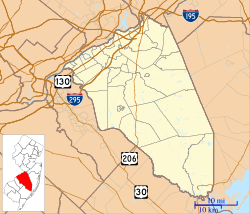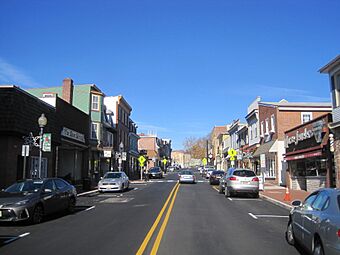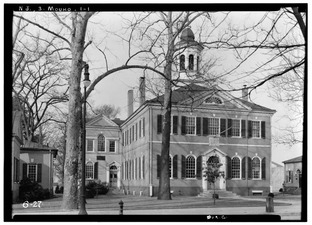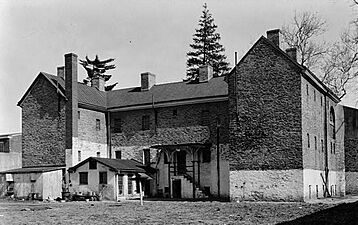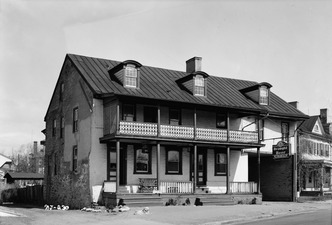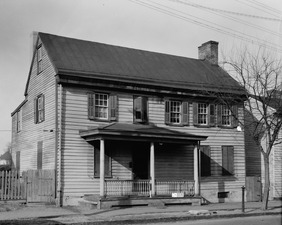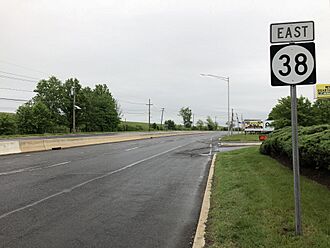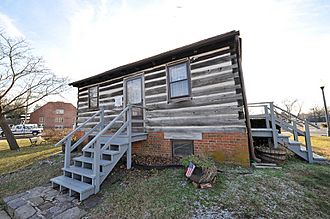Mount Holly, New Jersey facts for kids
Quick facts for kids
Mount Holly, New Jersey
|
||
|---|---|---|
|
Township
|
||
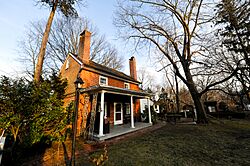
John Woolman Memorial in Mount Holly
|
||
|
||
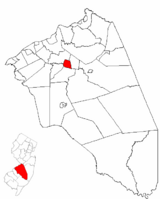
Location of Mount Holly in Burlington County highlighted in red (right). Inset map: Location of Burlington County in New Jersey highlighted in red (left).
|
||
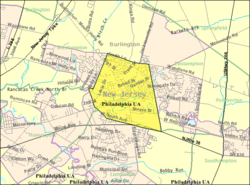
Census Bureau map of Mount Holly Township, New Jersey
|
||
| Country | ||
| State | ||
| County | Burlington | |
| Settled | 1677 | |
| Formed | November 6, 1688 as Northampton | |
| Incorporated | February 21, 1798 | |
| Renamed | November 6, 1931 as Mount Holly | |
| Named for | Hill covered with holly trees | |
| Government | ||
| • Type | Faulkner Act (council–manager) | |
| • Body | Township Council | |
| Area | ||
| • Total | 2.87 sq mi (7.43 km2) | |
| • Land | 2.82 sq mi (7.31 km2) | |
| • Water | 0.05 sq mi (0.12 km2) 1.60% | |
| Area rank | 345th of 565 in state 31st of 40 in county |
|
| Elevation | 36 ft (11 m) | |
| Population
(2020)
|
||
| • Total | 9,981 | |
| • Estimate
(2023)
|
10,151 | |
| • Rank | 245th of 565 in state 15th of 40 in county |
|
| • Density | 3,534.3/sq mi (1,364.6/km2) | |
| • Density rank | 192nd of 565 in state 9th of 40 in county |
|
| Time zone | UTC−05:00 (Eastern (EST)) | |
| • Summer (DST) | UTC−04:00 (Eastern (EDT)) | |
| ZIP Code |
08060
|
|
| Area code(s) | 609 | |
| FIPS code | 3400548900 | |
| GNIS feature ID | 0882104 | |
Mount Holly is a township in Burlington County, New Jersey. It is the main town, or "county seat," for Burlington County. Mount Holly is located just east of Philadelphia, a large city in the United States.
In 2020, about 9,981 people lived in Mount Holly. The town is part of a larger area that includes Philadelphia, Reading, and Camden.
Mount Holly was first called Northampton when it was formed in 1688. It became one of New Jersey's first 104 townships in 1798. Over the years, parts of Northampton were used to create other nearby towns. The town was officially renamed Mount Holly in 1931. It got its name from hills in the area that were covered with holly trees.
The National Weather Service has a weather office named after Mount Holly. This office helps forecast weather for most of New Jersey, parts of Pennsylvania, all of Delaware, and eastern Maryland. However, the office is actually located in the next town over, Westampton.
Contents
Mount Holly's History
Early Settlement and Mills
The first European settlers came to what is now Mount Holly in 1677. Walter Reeves bought land from the Lenape (Delaware) Native Americans. He built a dam on Rancocas Creek to power a gristmill (for grinding grain) and a sawmill. More settlers came to the area after the mills were built. They constructed homes and shops on streets like High, Church, White, Mill, and Pine. One of the oldest homes, the Shinn Curtis Log House, was built in 1712. By 1800, there were over 250 homes.
Today, the mills are gone, but the raceway (the channel that carried water to the mills) still flows. This raceway was important for fish like herring, which would swim upstream each spring. This provided fresh fish for the community. The land where the mills once stood is now a park called Mill Dam Park.
Revolutionary War Events
In December 1776, during the American Revolutionary War, American soldiers led by Colonel Samuel Griffin came to Mount Holly. They set up cannons on Iron Works Hill. The Hessian commanders (German soldiers fighting for the British) were told that 3,000 American troops were in Mount Holly.
By December 23, 1776, about 2,000 Hessians moved to Mount Holly. They had a three-day battle with the Americans, known as the Battle of Iron Works Hill. The Americans then secretly left during the night.
This battle was important because it drew many Hessian troops to Mount Holly. This helped George Washington and the Continental Army succeed in the Battle of Trenton the next day. The victory at Trenton greatly improved the American soldiers' spirits after a tough period.
Growth in the 1800s
In 1793, the state decided to move the main office of Burlington County from Burlington City to Mount Holly. This was approved by voters in 1796. Important buildings were then built, including the courthouse in 1796 and the county prison around 1819. The Burlington County Prison was designed by Robert Mills, a famous architect who also designed the Washington Monument. Mount Holly has many old buildings from the 1700s and 1800s, most of which are part of the Mount Holly Historic District.
In 1849, the Burlington and Mount Holly Railroad was built. This connected Mount Holly to communities along the Delaware River and to Philadelphia. This railroad helped industries grow in the area. Another railroad, the Camden and Mount Holly Railroad, built a station in town about 20 years later.
Mount Holly in the 1900s
A trolley station was built in 1904, allowing people to travel to nearby towns like Burlington City and Moorestown. New town buildings were also constructed in the 1900s. These included the Town Hall (1930) and the U.S. Post Office (1935). Both were built with money from the government during the Great Depression, as part of President Franklin D. Roosevelt's Works Progress Administration projects.
In the late 1950s, Mount Holly faced economic challenges. Many factory jobs were lost as mills and dye factories closed down. For a while, jobs at nearby military bases, Fort Dix and McGuire Air Force Base, helped. However, after the Vietnam War, these bases became smaller, and more jobs were lost. Also, many shopping malls opened in the Philadelphia area, which hurt local businesses in Mount Holly.
Mount Holly Historic District
The Mount Holly Historic District is a special area in downtown Mount Holly. It covers about 260 acres and has many important old buildings. This district was added to the National Register of Historic Places in 1973. It is important for its architecture, history of education, government, and transportation.
The district includes 39 historic buildings. The Old Schoolhouse, also known as the Brainerd School, was built in 1759. The Burlington County Prison is also part of the district and was named a National Historic Landmark in 1986. The Burlington County Courthouse was built in 1796.
-
Burlington County Courthouse, HABS photo, 1936
Mount Holly's Geography
Mount Holly covers about 2.87 square miles. Most of this area is land, with a small amount of water. The town shares borders with other towns in Burlington County. These include Eastampton Township, Hainesport Township, Lumberton, and Westampton.
Mount Holly's Climate
| Climate data for South Jersey Regional Airport, 1991–2020 normals, extremes 1997–present | |||||||||||||
|---|---|---|---|---|---|---|---|---|---|---|---|---|---|
| Month | Jan | Feb | Mar | Apr | May | Jun | Jul | Aug | Sep | Oct | Nov | Dec | Year |
| Record high °F (°C) | 72 (22) |
77 (25) |
88 (31) |
95 (35) |
96 (36) |
99 (37) |
104 (40) |
100 (38) |
98 (37) |
94 (34) |
80 (27) |
74 (23) |
104 (40) |
| Mean maximum °F (°C) | 64.4 (18.0) |
63.4 (17.4) |
74.3 (23.5) |
84.5 (29.2) |
89.5 (31.9) |
94.1 (34.5) |
97.1 (36.2) |
93.6 (34.2) |
91.1 (32.8) |
82.7 (28.2) |
72.6 (22.6) |
66.3 (19.1) |
97.7 (36.5) |
| Mean daily maximum °F (°C) | 41.0 (5.0) |
44.0 (6.7) |
52.0 (11.1) |
63.5 (17.5) |
73.3 (22.9) |
81.9 (27.7) |
87.0 (30.6) |
84.8 (29.3) |
77.9 (25.5) |
66.3 (19.1) |
55.6 (13.1) |
45.6 (7.6) |
64.4 (18.0) |
| Daily mean °F (°C) | 32.8 (0.4) |
34.8 (1.6) |
42.5 (5.8) |
52.6 (11.4) |
62.2 (16.8) |
71.5 (21.9) |
76.6 (24.8) |
74.4 (23.6) |
67.2 (19.6) |
55.9 (13.3) |
45.7 (7.6) |
37.4 (3.0) |
54.5 (12.5) |
| Mean daily minimum °F (°C) | 24.6 (−4.1) |
25.7 (−3.5) |
32.9 (0.5) |
41.6 (5.3) |
51.1 (10.6) |
61.0 (16.1) |
66.2 (19.0) |
64.0 (17.8) |
56.5 (13.6) |
45.6 (7.6) |
35.9 (2.2) |
29.1 (−1.6) |
44.5 (6.9) |
| Mean minimum °F (°C) | 7.9 (−13.4) |
10.6 (−11.9) |
18.3 (−7.6) |
28.7 (−1.8) |
37.4 (3.0) |
48.0 (8.9) |
55.9 (13.3) |
52.9 (11.6) |
43.6 (6.4) |
30.8 (−0.7) |
21.4 (−5.9) |
16.5 (−8.6) |
5.9 (−14.5) |
| Record low °F (°C) | −3 (−19) |
−2 (−19) |
2 (−17) |
22 (−6) |
34 (1) |
42 (6) |
43 (6) |
44 (7) |
37 (3) |
27 (−3) |
13 (−11) |
7 (−14) |
−3 (−19) |
| Average precipitation inches (mm) | 2.97 (75) |
2.57 (65) |
3.83 (97) |
3.37 (86) |
2.95 (75) |
3.73 (95) |
5.19 (132) |
4.40 (112) |
3.39 (86) |
3.67 (93) |
2.98 (76) |
3.74 (95) |
42.79 (1,087) |
| Average precipitation days (≥ 0.01 in) | 9.9 | 10.4 | 11.5 | 10.7 | 12.1 | 11.7 | 11.2 | 11.3 | 11.1 | 11.0 | 8.9 | 10.5 | 130.3 |
| Source: NOAA (mean maxima/minima 2006–2020) | |||||||||||||
Mount Holly's Population
| Historical population | |||
|---|---|---|---|
| Census | Pop. | %± | |
| 1800 | 3,559 | — | |
| 1810 | 4,171 | * | 17.2% |
| 1820 | 4,833 | 15.9% | |
| 1830 | 5,516 | * | 14.1% |
| 1840 | 6,813 | 23.5% | |
| 1850 | 3,031 | * | −55.5% |
| 1860 | 3,322 | 9.6% | |
| 1870 | 4,018 | * | 21.0% |
| 1880 | 4,630 | 15.2% | |
| 1890 | 5,376 | 16.1% | |
| 1900 | 5,168 | −3.9% | |
| 1910 | 5,652 | 9.4% | |
| 1920 | 5,901 | 4.4% | |
| 1930 | 6,573 | 11.4% | |
| 1940 | 6,892 | 4.9% | |
| 1950 | 8,206 | 19.1% | |
| 1960 | 13,271 | 61.7% | |
| 1970 | 12,713 | −4.2% | |
| 1980 | 10,818 | −14.9% | |
| 1990 | 10,639 | −1.7% | |
| 2000 | 10,728 | 0.8% | |
| 2010 | 9,536 | −11.1% | |
| 2020 | 9,981 | 4.7% | |
| 2023 (est.) | 10,151 | 6.4% | |
| Population sources: 1800–2000 1800–1920 1840 1850–1870 1850 1870 1880–1890 1890–1910 1910–1930 1940–2000 2000 2010 2020 * = Lost territory in previous decade. |
|||
Population in 2010
The 2010 United States census counted 9,536 people living in Mount Holly. There were 3,456 households and 2,264 families. The population density was about 3,398 people per square mile.
About 65.6% of the people were White, and 23.1% were Black or African American. About 12.7% of the population was Hispanic or Latino.
About 23.5% of the people were under 18 years old. About 11.1% were 65 years or older. The average age was 36.3 years.
Mount Holly's Economy
Mount Holly is part of an Urban Enterprise Zone (UEZ). This is a special program in New Jersey that helps towns grow their economy. Mount Holly joined the program in 1994.
Being a UEZ means that shoppers can pay a lower sales tax of 3.3125% at certain stores. This is half of the regular state tax rate. This program helps create jobs and encourages businesses to invest in the town. Mount Holly's UEZ status will last until March 2026.
Education in Mount Holly
Local Schools
Students in pre-kindergarten through eighth grade attend schools run by the Mount Holly Township Public Schools. In the 2021–22 school year, about 1,079 students were enrolled across three schools. There was about one teacher for every 10 students.
The schools are:
- John Brainerd School (PreK-1st grade)
- Gertrude C. Folwell School (2nd-4th grade)
- F. W. Holbein Middle School (6th-8th grade)
High School Education
For ninth through twelfth grades, students go to Rancocas Valley Regional High School. This high school is located in Mount Holly. It also serves students from four other nearby towns: Eastampton Township, Hainesport Township, Lumberton, and Westampton.
In the 2021–22 school year, the high school had about 2,048 students. There was about one teacher for every 14 students. The school board has nine members who are elected by voters. Mount Holly has two seats on this board.
Vocational and Private Schools
Students from Mount Holly can also attend the Burlington County Institute of Technology. This is a public school district for the entire county. It offers vocational and technical training for high school and adult students. It has campuses in Medford and Westampton.
Sacred Heart School is a Catholic school in Mount Holly. It serves students from PreK through 8th grade.
Transportation in Mount Holly
Mount Holly has many roads. The town maintains about 29 miles of roads. Burlington County maintains about 8 miles, and the state maintains less than 1 mile.
The main state highway that goes through Mount Holly is Route 38. Other important county roads include County Route 537 and County Route 541.
You can reach Mount Holly from major highways like the New Jersey Turnpike (Exit 5) and Interstate 295 (Exit 47).
NJ Transit provides bus service to Mount Holly. You can take buses to Philadelphia or to other nearby towns like Camden and Burlington.
Points of Interest in Mount Holly
- Burlington County Courthouse: Built in 1796, this historic building serves as the county's main court.
- Mount Holly Cemetery: A historic cemetery in the town.
- Shinn Curtis Log House: This house was built in 1712 using hand-hewn logs. It was discovered and restored in 1967.
- Burlington County Prison: Opened in 1819, this prison was the oldest continuously running prison in the country when it closed in 1965.
- First Presbyterian Church: A historic church in Mount Holly.
- St. Andrew's Episcopal Church: Another historic church in the town.
- Friends Meeting House: A meeting place for the Quaker community.
- Brainerd Schoolhouse: This one-room schoolhouse was built in 1759. It operated as a school for almost 100 years.
- Relief Fire Company No. 1: Home to the oldest continuously operating volunteer fire company in the United States.
- Thomas Budd House: The third-oldest house in the township, built in 1744.
- Stephen Girard House: The home of Stephen Girard, a famous merchant and banker, who lived here in the late 1700s.
- John Woolman Memorial: Built in the late 1700s on land that once belonged to John Woolman, a famous Quaker preacher.
Notable People from Mount Holly
Many interesting people have been born in, lived in, or are connected to Mount Holly:
- James William Abert (1820–1897), a soldier and explorer.
- Cindy Birdsong (born 1939), a singer who joined the famous group The Supremes.
- Zach Braddock (born 1987), a baseball pitcher for the Milwaukee Brewers.
- Shaun Bradley (born 1997), an American football player for the Philadelphia Eagles.
- Matthew Emmons (born 1981), an Olympic sport shooter who won a gold medal.
- Irving Fryar (born 1962), a former Philadelphia Eagles football player.
- Stephen Girard (1750–1831), a well-known merchant, banker, and giver to charity.
- Franco Harris (born 1950), a famous former Pittsburgh Steelers football player.
- Dwight Hicks (born 1956), a former NFL football player for the San Francisco 49ers.
- Peter Hill (1767–1820), a former slave who became the first African American clockmaker.
- Isabeau Levito (born 2007), a talented figure skater.
- Ricky Lumpkin (born 1988), a former NFL football player.
- Britt McHenry (born 1986), a sports reporter.
- Barbara Park (1947–2013), an author known for her "Junie B. Jones" books for children.
- Alonzo Spellman (born 1971), a former NFL football player.
- John Woolman (1720–1772), a noted Quaker preacher and early supporter of ending slavery.
See also
 In Spanish: Municipio de Mount Holly para niños
In Spanish: Municipio de Mount Holly para niños



